Overview of Vegvisir
The Vegvisir, often hailed as the Viking compass, holds a revered place within Norse culture for its distinctive and enigmatic design. The symbol’s name itself reveals its purpose (Icelandic for “wayfinder”, ‘way shower’).
This combination defines the Vegvisir as a guide, designed to prevent the bearer from losing their path.Originally recorded in Icelandic grimoires, this runic compass is not just a piece of ancient symbolism but a guiding beacon for those navigating through life’s metaphorical storms.
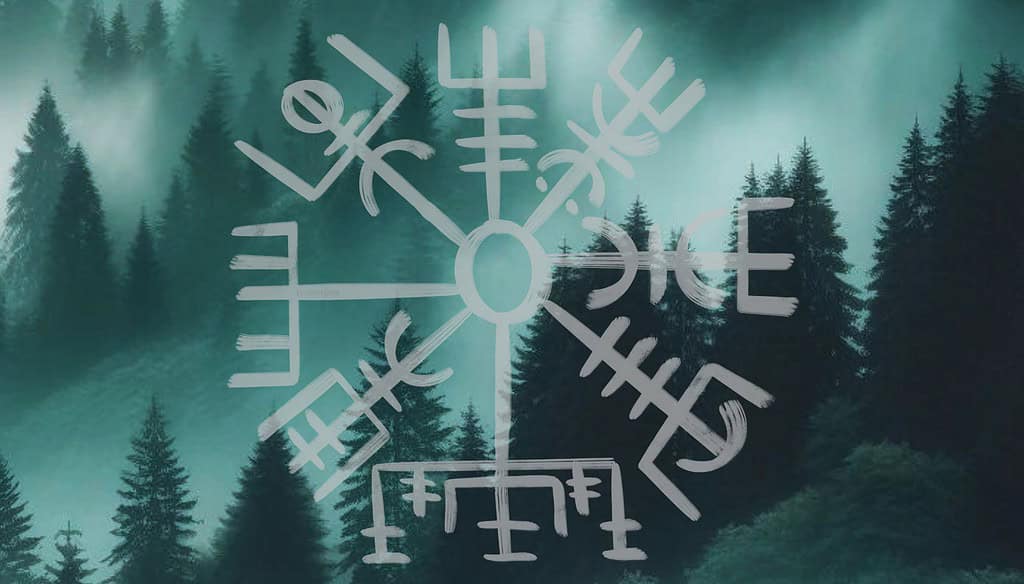
Table of Contents
The Origins and Historical Context
Roots in Icelandic Grimoires
The Vegvisir, often celebrated as a symbol of guidance, finds its earliest known depictions in the mystical realm of Icelandic magical staves, particularly highlighted in the famed Huld manuscript. Authored in the 19th century by Geir Vigfússon, this manuscript is a treasure trove of runic knowledge, compiling various symbols used throughout Iceland for protection, healing, and guidance. The presence of the Vegvisir within this collection sets the historical foundation for its significance but also marks the beginning of debates about its origins.
Authenticity and Historical Accuracy
The historical authenticity of the Vegvisir as a Viking-era symbol has been a subject of considerable debate among scholars and enthusiasts alike. While the Vegvisir is documented for the first time in the 19th-century Huld manuscript, there is no direct evidence of its use or recognition during the Viking Age. This discrepancy has led to two primary schools of thought:
- Traditionalist View: Some historians argue that the absence of archaeological evidence does not necessarily negate the Vegvisir’s Viking origins. They suggest that oral traditions could have preserved the symbol’s use and meaning well before it was recorded in manuscripts, supporting a continuity of cultural practices across centuries.
- Critical Perspective: Conversely, other scholars caution against anachronistically assigning a Viking identity to symbols like the Vegvisir. They emphasize the importance of distinguishing between actual Viking artifacts and later Icelandic creations, which may have been influenced by a blend of pagan and Christian symbolism.
Connection with Norse Mythology and Viking Culture
Despite the Vegvisir’s absence in Viking-era texts, its thematic and symbolic connections to Norse mythology and Viking navigational practices cannot be entirely dismissed. The use of symbols and runes for protection and guidance was pervasive in these ancient societies, a practice likely influencing the conceptualization of the Vegvisir within Icelandic traditions of the 19th century. This speculative link suggests a cultural transmission that adapted Norse symbolic practices to the spiritual and practical needs of later Icelandic society, bridging ancient traditions with evolving cultural narratives.
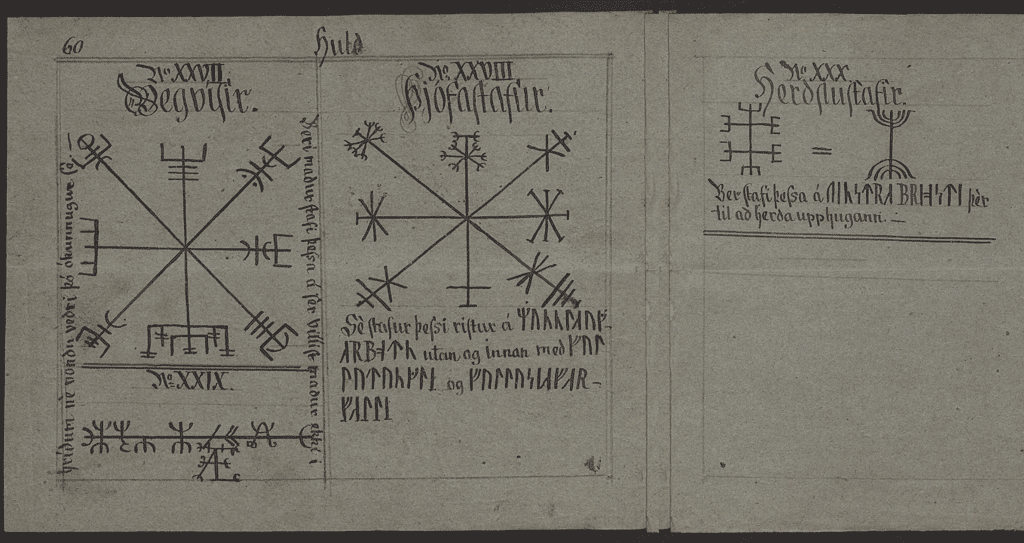
Symbolism and Meanings
Core Meanings and Functions
The Vegvisir, often termed as the Viking compass, is primarily recognized for its role as a navigational aid. This powerful symbol was believed to help prevent seafarers and travelers from losing their way during bad weather and in unfamiliar surroundings. Beyond its literal application, the Vegvisir also functions as a symbol of spiritual guidance, offering protection and security. Its depiction in Icelandic magical staves suggests a profound belief in its ability to safeguard one’s journey, not just physically but also metaphysically, guiding the soul through the spiritual landscape of Norse paganism.
The Runic Composition and Its Significance
Each line and curve in the Vegvisir is composed of specific runic staves known from ancient Norse culture. These runes are more than mere markings; they encapsulate magical powers and deep spiritual significance. The arrangement of these runes within the Vegvisir is thought to be deliberate, harnessing the individual energies of the runes to create a sum greater than its parts. The exact interpretation of each rune within the compass varies, but collectively, they are believed to work in harmony to provide a shield of protection and clarity for the bearer.
Comparative Symbols: Helm of Awe and Others
When compared to other Norse symbols, the Vegvisir holds unique distinctions. The Helm of Awe, or Ægishjálmur, another prominent symbol from the same cultural repository, was primarily used as a symbol of might and protection in battle, often inscribed on warriors’ foreheads to induce fear in enemies and prevent harm to the wearer.
Unlike the Helm of Awe’s martial connotations, the Vegvisir’s use is more benign, focusing on safeguarding and guidance. This distinction highlights the Vegvisir’s role as a more encompassing emblem of protection that extends beyond the battlefield to the challenges of daily life and spiritual journeying within the Norse and wider pagan practices.
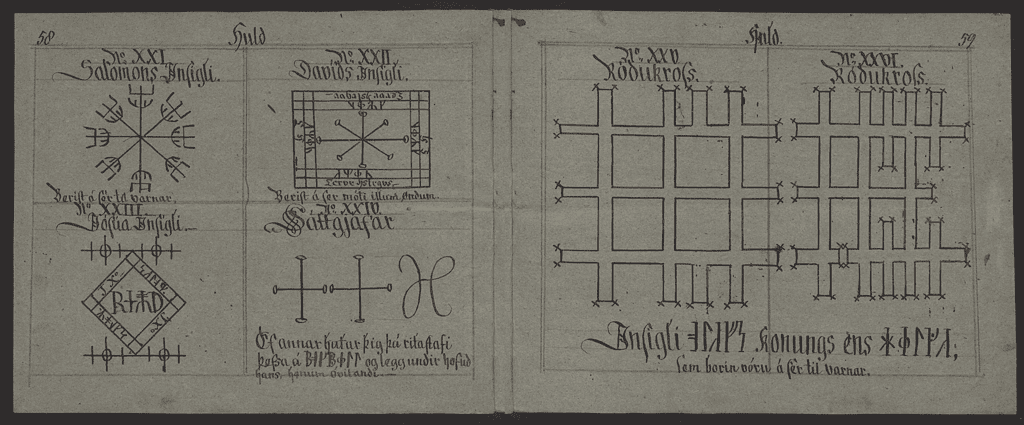
Vegvisir in Modern Design and Jewelry
Incorporation in Jewelry Designs
The timeless allure of the Vegvisir has seamlessly transitioned into the realm of modern jewelry, where its intricate design has been elegantly adapted into various forms such as rings, pendants, lockets, and ear cuffs. This blend of old and new not only enhances the aesthetic value but also keeps the symbol relevant in today’s fashion landscape.
Spotlight on The Wicked Griffin Shop Products
My handcrafted-by-me-yes-the-person-who-wrote-this-article collection features several standout pieces that embody the spirit and design of the Vegvisir.
-
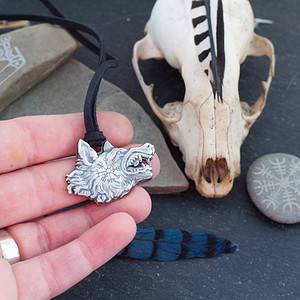 Fenrir Pendant Necklace with Vegvisir$90.00
Fenrir Pendant Necklace with Vegvisir$90.00 -
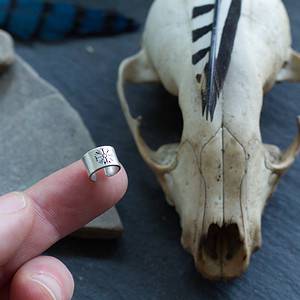 Vegvisir Tiny Fine Silver Ear Cuff$14.00
Vegvisir Tiny Fine Silver Ear Cuff$14.00 -
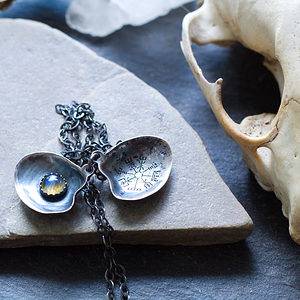 Vegvisir & Labradorite Clamshell Locket$149.00
Vegvisir & Labradorite Clamshell Locket$149.00 -
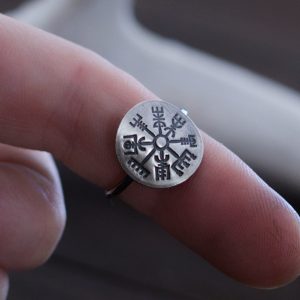 Dainty Vegvisir Ring$39.00
Dainty Vegvisir Ring$39.00 -
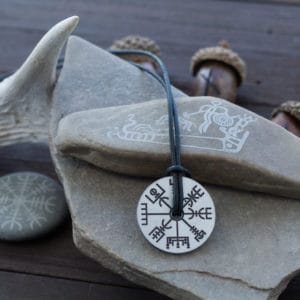 Vegvisir Necklace – Choose your metal$31.00 – $64.00
Vegvisir Necklace – Choose your metal$31.00 – $64.00
These items are not only decorative but serve as modern amulets, connecting wearers with a lineage of Norse tradition.
Symbolic Meanings Translated into Jewelry
Wearing Vegvisir jewelry transcends mere fashion, embodying a deeper connection to its roots as a symbol of protection and guidance. Each piece serves as a personal talisman, believed to confer the Vegvisir’s navigational and protective benefits to its wearer.
In today’s context, this might translate to feeling centered and directed amidst life’s chaos, drawing on the historical essence of the symbol to provide not just physical but emotional and spiritual alignment. This synthesis of beauty, history, and personal significance makes Vegvisir jewelry a meaningful choice for those who feel a connection to Norse mythology and the broader pagan practices.
Modern Usage and Cultural Impact
Vegvisir in Contemporary Art and Tattoo Culture
The Vegvisir has permeated contemporary art and culture, particularly distinguishing itself in the world of tattoo design, where it holds significant appeal among enthusiasts of Norse mythology and Viking culture. Tattoo artists often recommend the Vegvisir to those seeking symbols that represent guidance and protection, reflecting its ancient roots in a modern medium.
The symbol’s intricate and appealing design translates effectively onto skin, making it a popular choice not only for its aesthetic appeal but also for its deep symbolic resonance with those looking to embody the spirit of the Viking navigators in their own journeys through life.
The Symbol’s Role in Modern Pagan and Norse Practices
In modern pagan and Norse practices, the Vegvisir has evolved from a historical emblem of guidance to a potent symbol used in various ritualistic and spiritual contexts. Practitioners often use the Vegvisir within their magical workings to enhance spiritual clarity and protect against misfortune.
It’s not uncommon to see the Vegvisir incorporated into ceremonial tools, altar decorations, and amulets, where it is revered not just for its physical beauty but for its ability to align with the energies of the practitioner, providing a focal point for meditation and spiritual navigation. This adaptation underscores the Vegvisir’s transition from a mere navigational aid to a multifaceted symbol that enriches the spiritual lives of those who draw from Norse traditions.
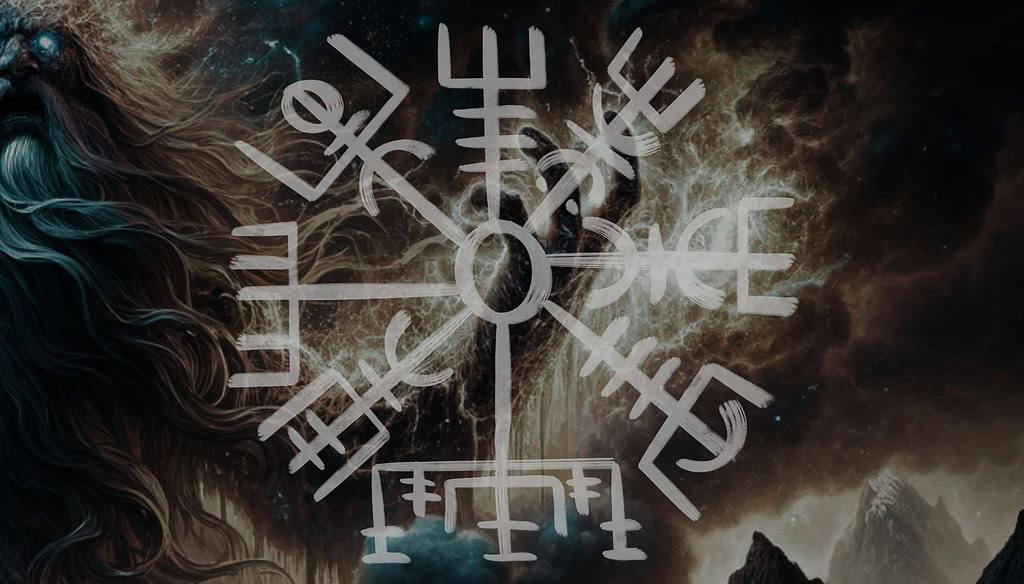
Debates and Misconceptions
Authenticity and Historical Accuracy
A central debate surrounding the Vegvisir concerns its authenticity and origins as a Viking-era symbol. Scholars and enthusiasts alike have scrutinized the historical accuracy of the Vegvisir’s connection to ancient Norse culture, noting that the first documented references appear significantly later, in 19th-century Icelandic grimoires rather than in Viking-age artifacts or texts.
This gap in the historical record prompts a reevaluation of the Vegvisir’s role and significance: rather than viewing it strictly as a product of Viking tradition, it may be more accurate to consider it a part of the broader Icelandic heritage, shaped by a mixture of older traditions and later interpretations.
Interpretations of Christian Influence and Other Theories
The design and use of the Vegvisir have also been subjects of speculation regarding potential Christian influence. Some theorists suggest that the cross-like elements found in some depictions of the Vegvisir may indicate a synthesis of pagan symbols and Christian iconography, reflecting the complex interplay of cultural and religious exchanges in post-Viking Iceland.
Additionally, the broader incorporation of runic symbols in medieval Icelandic manuscripts, which were often compiled under Christian oversight, might hint at a layered development, where pagan and Christian elements coalesced into new symbolic forms. Such theories underscore the dynamic and evolving nature of symbols like the Vegvisir, which may have adapted over centuries to encompass a range of meanings and influences, far beyond their original scope.
Final Thoughts on the Vegvisir
Summary of Key Insights and Personal Reflection
Throughout this exploration of the Vegvisir, we have uncovered its layers of meaning from ancient roots to modern expressions. While the Vegvisir may not originate from the Viking age, its connection to Norse culture through Icelandic magical staves and its symbolic importance as a navigational and protective emblem are undeniable.
Today, its adoption in jewelry not only keeps the symbol alive but also allows individuals to carry a piece of Norse mythology with them. I invite you to reflect on how symbols like the Vegvisir can influence your personal identity and connection to heritage, particularly when these ancient icons are woven into the fabric of our daily lives through beautiful, meaningful jewelry.
FAQ: Understanding the Vegvisir and Related Norse Symbols
1. What does the Viking compass symbolize?
- The Viking compass, or Vegvisir, symbolizes guidance and protection. It was believed to help the bearer navigate through rough weather and avoid getting lost.
2. What is the Viking path symbol?
- The Viking path symbol, often identified with the Vegvisir, represents a tool for finding one’s way—a spiritual and literal guide in navigating life’s challenges.
3. What is the Norse wayfinding symbol?
- The Norse wayfinding symbol, also known as the Vegvisir, was used to guide people through difficult weather conditions and unfamiliar territories, ensuring they reach their destinations safely.
4. What does the Helm of Awe and Vegvisir mean?
- The Helm of Awe (Ægishjálmur) is a symbol of protection and might, used to induce fear and protect against abuse of power. The Vegvisir, on the other hand, is used for navigation and protection from getting lost.
5. How does a Viking compass work?
- The Viking compass or Vegvisir was believed to work magically by providing spiritual guidance. It was not a physical navigating tool but a symbol carried as a protective talisman to ensure safe passage.
6. What is the meaning of the cross on the Vegvisir symbol?
- The cross within the Vegvisir is likely a later addition reflecting Christian influences, symbolizing integration of pagan symbols with Christian elements in post-Viking Iceland.
7. What do the symbols around and in the Vegvisir mean?
- The symbols around the Vegvisir are runic staves, each with specific magical properties intended to augment the Vegvisir’s ability to provide guidance and protection.
8. What is the Icelandic symbol for protection?
- While the Vegvisir is often used for navigation, the Helm of Awe is another powerful Icelandic symbol specifically known for its protective properties.
9. Is the Vegvisir truly connected to Norse culture?
- The Vegvisir, as documented in 19th-century Icelandic grimoires, reflects Norse cultural elements, though it is not directly sourced from the Viking age but rather from later Icelandic traditions.
10. What are the runes around the Vegvisir?
- The runes around the Vegvisir include various runic staves known from Icelandic magic, each chosen for their abilities to protect and guide.
11. Is the Helm of Awe a simplified Vegvisir symbol?
- No, the Helm of Awe and the Vegvisir serve different purposes and have different designs. The Helm of Awe is a protective symbol, while the Vegvisir guides.
12. What are some examples of unique Viking symbols and their meanings?
- Apart from the Vegvisir and Helm of Awe, other Viking symbols include the Valknut, symbolizing the afterlife, and the Yggdrasil, representing the cosmos and connectivity.
13. Does the Vegvisir have Christian origins?
- The Vegvisir itself does not have Christian origins, though its documented form with a cross might reflect Christian overlay in later Icelandic practices.
14. What are some good Nordic symbols?
- Good Nordic symbols for various uses include the Vegvisir for guidance, the Helm of Awe for protection, and Mjolnir, Thor’s hammer, symbolizing strength and protection.
This FAQ provides insights into some of the most common inquiries regarding the Vegvisir and other Norse symbols, reflecting their rich meanings and the cultural interplay of pagan traditions and modern interpretations.
